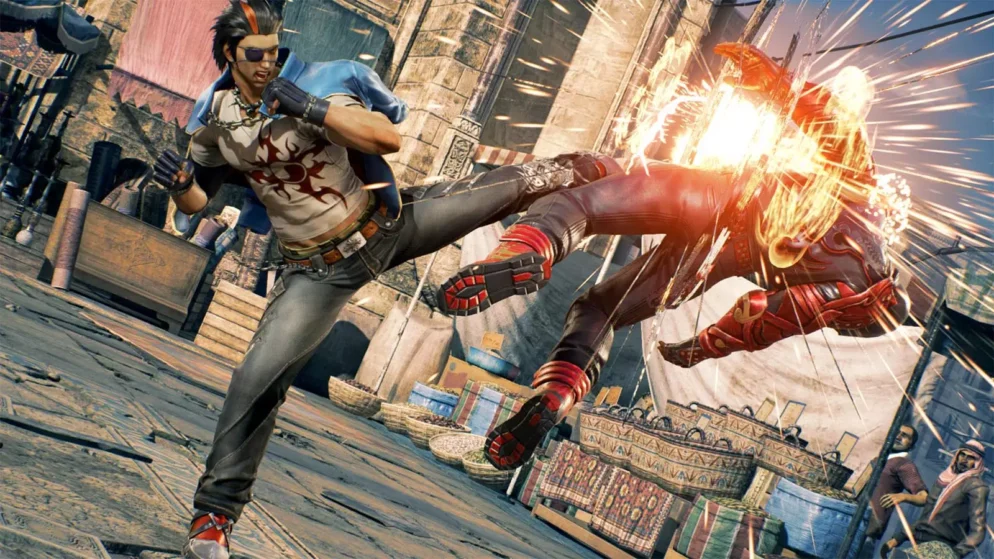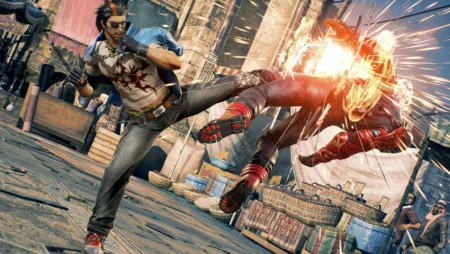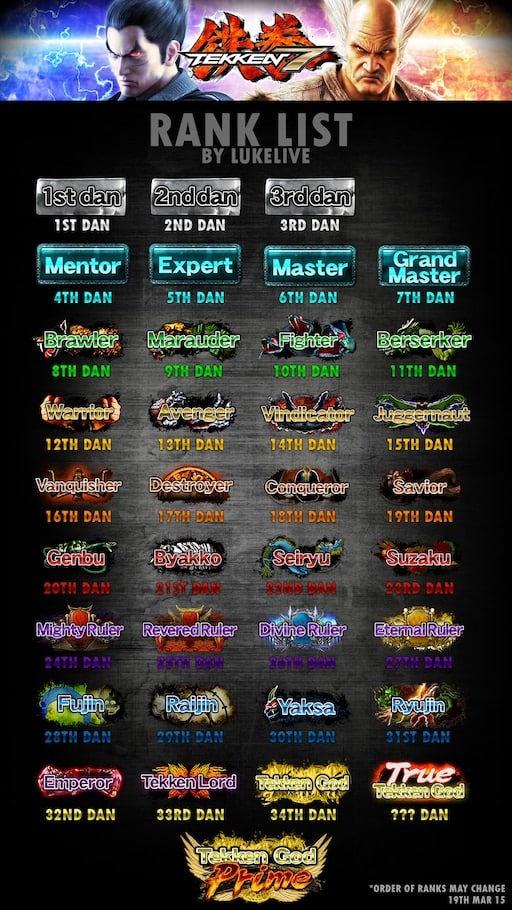

Tekken 7 Ranks: A Comprehensive Guide to Ranking Up in the Game
Tekken 7 is a popular fighting game that has been played by millions of gamers worldwide. One of the most exciting aspects of the game is its ranking system, which allows players to progress through various tiers and ranks as they win matches and improve their skills. The ranking system in Tekken 7 is both complex and rewarding, offering players a sense of accomplishment as they climb up the ladder and compete against other skilled players.
The ranking system in Tekken 7 is based on a point-based system that determines a player's rank. Winning matches earns players points, while defeats cause them to lose points. The amount of points earned or lost depends on the opponent's rank, with beating players of the same rank yielding the most points. The game has a total of 46 ranks that players can work through, each with a variety of different titles to match. In offline mode, players start their ranked journey with the title of Beginner, while in online play, there are 37 ranks split up across ten different tiers. Climbing higher in rank requires a significant investment of time and dedication, but the rewards are well worth it for those who are willing to put in the effort.
Overall, the ranking system in Tekken 7 is an essential part of the game and provides players with a sense of progression and accomplishment as they work to improve their skills and climb the ranks. Whether you're a beginner just starting or a seasoned veteran looking to reach the top, the ranking system in Tekken 7 offers a challenging and rewarding experience for all players.
Understanding Tekken 7 Ranks

Tekken 7 features a ranking system that allows players to track their progress and measure their skill level against others. The ranking system comprises 46 ranks in total, each with its own title and set of requirements.
Players start their ranked journey with the Beginner rank and work their way up through the ranks by winning matches and earning points. The higher the rank, the more points are required to progress to the next rank.
The ranks in Tekken 7 are divided into five tiers: Green, Yellow, Orange, Red, and Blue. Each tier has its own set of ranks, with the Green tier being the lowest and the Blue tier being the highest.
To progress through the ranks, players must win matches against opponents of similar or higher rank. The number of points earned for a win depends on the opponent's rank and the player's own rank. Players can also earn bonus points for winning streaks and performing well in matches.
It's important to note that the ranking system in Tekken 7 is based on a player's performance in online matches. Offline matches do not affect a player's rank.
Overall, the ranking system in Tekken 7 is a great way to measure your progress and skill level in the game. As you progress through the ranks, you'll face tougher opponents and learn new strategies and techniques.
Tekken 7 Ranking System
Tekken 7 has a complex ranking system that determines a player's skill level and assigns them a rank based on their performance in online matches. The ranking system is divided into two main categories: Ranking Points and Ranking Tiers.
Ranking Points
Ranking Points are earned by winning matches against other players online. The amount of Ranking Points a player earns for a win depends on the opponent's rank and their own rank. The higher the opponent's rank and the lower the player's rank, the more Ranking Points they will earn for a win. Conversely, if the opponent's rank is lower than the player's rank, the player will earn fewer Ranking Points for a win.
Ranking Tiers
Ranking Tiers are determined by the number of Ranking Points a player has earned. There are a total of 40 different Ranking Tiers in Tekken 7, ranging from Beginner to Tekken God Prime. Each Ranking Tier has a set number of Ranking Points that a player must earn to be promoted to the next tier.
Promotion and Demotion Rules
In addition to earning Ranking Points, players must also meet certain criteria to be promoted to a higher Ranking Tier. For example, in order to be promoted from Beginner to 1st Dan, a player must win three matches in a row. Similarly, to be promoted from Genbu to Byakko, a player must win 10 matches in a row.
If a player loses too many matches, they may be demoted to a lower Ranking Tier. The number of losses a player can sustain before being demoted depends on their current rank. For example, a player in the Tekken God Prime rank can only lose one match before being demoted, while a player in the Beginner rank can lose up to five matches before being demoted.
In conclusion, the Tekken 7 Ranking System is a complex and challenging system that requires players to not only win matches but also meet certain criteria to be promoted to higher ranks. Players must also be careful not to lose too many matches, or they may be demoted to a lower rank.
Character Ranks in Tekken 7
Tekken 7 features a ranking system that allows players to gauge their skill level and progress in the game. There are 37 ranks split into 10 tiers, with each rank representing a different level of skill. The ranking system is based on the number of Rank Points (RP) a player accumulates.
The ranking system in Tekken 7 is divided into two categories: Character Ranks and Overall Ranks. Character Ranks are specific to each character, while Overall Ranks are based on a player's performance across all characters.
Each character in Tekken 7 has its own rank, which is determined by the number of RP a player has accumulated while playing that character. The more RP a player has, the higher their rank will be. The highest rank a player can achieve with a character is Tekken God Prime.
It is important to note that the ranking system in Tekken 7 is not a true determiner of a player's skill level. A player's rank can be influenced by a variety of factors, including the number of matches played, the skill level of their opponents, and the character they are playing.
In conclusion, the character ranking system in Tekken 7 provides players with a way to gauge their skill level and progress in the game. However, it is important to remember that a player's rank is not a true determiner of their skill level, and should be taken with a grain of salt.
Tekken 7 Rank Distribution
Tekken 7 ranks are divided into several tiers, with each tier consisting of several ranks. The highest tier is Tekken God Prime, and the lowest tier is Beginner. The rank distribution and percentage of players by tier in Tekken 7 on PC are as follows:
- Beginner: 0.50%
- Initiate: 0.86%
- Mentor: 1.27%
- Grand Master: 1.79%
- Brawler: 2.63%
- Marauder: 3.48%
- Fighter: 4.27%
- Vanguard: 5.32%
- Warrior: 6.38%
- Usurper: 7.40%
- Juggernaut: 8.47%
- Vanquisher: 9.47%
- Destroyer: 10.47%
- Savior: 11.47%
- Overlord: 12.47%
- Genbu: 13.47%
- Byakko: 14.47%
- Seiryu: 15.47%
- Suzaku: 16.47%
- Fujin: 17.47%
- Raijin: 18.47%
- Yaksa: 19.47%
- Majin: 20.47%
- True Tekken God: 21.47%
- True Tekken God Prime: 22.47%
It's important to note that these percentages are based on PC players only, and the rank distribution may differ on other platforms.
Players can earn ranking points by winning matches against opponents with similar or higher ranks. The amount of points earned or lost depends on the opponent's rank. Beating players with the exact same rank as you yields the most points. The point system is used to determine a player's rank and progress through the tiers.
Overall, the Tekken 7 rank distribution is a good indicator of a player's skill level and progress in the game. Players can use this information to set goals and improve their gameplay to climb the ranks and reach the highest tier of Tekken God Prime.
How to Improve Your Tekken 7 Rank
Improving your rank in Tekken 7 requires dedication, practice, and a solid understanding of the game's mechanics. Here are some tips to help you climb the ranks:
Strategies for Beginners
For beginners, the best way to improve your rank is to focus on learning the basics of the game. This includes understanding the moveset of your chosen character, learning how to block and counterattack, and mastering basic combos.
One effective strategy for beginners is to focus on defense. By blocking and punishing your opponent's mistakes, you can slowly chip away at their health while minimizing your own risk. Once you feel comfortable with your defense, you can start incorporating more aggressive strategies into your gameplay.
Another important strategy for beginners is to practice your movement. Being able to move quickly and efficiently around the stage can give you a significant advantage over your opponent. Take some time to practice backdashing, sidestepping, and other movement techniques to improve your mobility.
Advanced Techniques
Once you've mastered the basics, it's time to start incorporating more advanced techniques into your gameplay. These can include things like frame data analysis, advanced combos, and more complex movement techniques.
One important technique for advanced players is to learn how to read your opponent. By paying attention to their habits and tendencies, you can anticipate their moves and counter them effectively. This can be especially useful against opponents who rely heavily on a certain move or strategy.
Another important technique for advanced players is to learn how to adapt to different situations. This can include adjusting your playstyle based on your opponent's character, the stage you're playing on, and other factors. Being able to adapt on the fly can give you a significant advantage in any match.
Common Mistakes to Avoid
There are also some common mistakes that players should avoid if they want to improve their rank in Tekken 7. These include things like relying too heavily on a single move or strategy, failing to punish your opponent's mistakes, and not paying attention to your opponent's habits and tendencies.
Another common mistake is to become too predictable in your gameplay. If your opponent can anticipate your moves, they can easily counter them and gain the upper hand. Try to mix up your playstyle and keep your opponent guessing to avoid falling into a pattern.
By following these tips and avoiding common mistakes, you can improve your rank in Tekken 7 and become a more skilled player. Remember to practice regularly, analyze your gameplay, and always be willing to learn and adapt to new challenges.
Impact of Tekken 7 Ranks on Gameplay
The ranks in Tekken 7 have a significant impact on gameplay. They determine who players are matched against in ranked matches and provide a sense of progression as players climb the ranks.
As players progress through the ranks, they are matched against opponents of similar skill levels. This ensures that matches are challenging and fair, which makes for a more enjoyable experience. The matchmaking system also prevents players from being matched against opponents who are either too easy or too difficult to beat.
In addition to providing a sense of progression, the ranks in Tekken 7 also serve as a form of recognition for players. Higher ranks are associated with titles that players can display next to their usernames. These titles are a way of showing off a player's skill level and dedication to the game.
Players who reach the higher ranks in Tekken 7 are also eligible to participate in official tournaments. These tournaments offer players the opportunity to compete against the best players in the world and win prizes.
However, it's important to note that ranks in Tekken 7 are not the only measure of a player's skill. There are many factors that contribute to a player's success in the game, including their knowledge of the game mechanics, their ability to read their opponent, and their execution of moves.
Overall, the ranks in Tekken 7 play a crucial role in the game's competitive scene. They provide a sense of progression, recognition, and eligibility for official tournaments.
Conclusion
In conclusion, Tekken 7 has a robust ranking system that offers players a variety of titles to achieve. Players can work their way up through 46 ranks, each with its own unique title. The ranking system is divided into seven tiers, each with its own set of ranks.
To climb the ranks, players must participate in ranked matches and earn ranking points. The higher the ranking points, the higher the player's rank. Players can also earn promotion matches, which allow them to skip ranks and move up to the next tier.
It's important to note that the ranking system is separate for online and offline play. While the ranks and titles are the same, the way in which players earn ranking points differs.
Overall, the Tekken 7 ranking system adds an extra layer of depth and challenge to the game. It rewards players for their skill and dedication, and provides a clear path for players to follow as they strive to become the best Tekken 7 player they can be.
Frequently Asked Questions
What are the different ranks in Tekken 7?
There are 46 ranks in Tekken 7, divided into five main categories: Kyu, Dan, Master, Grand Master, and Tekken God. Kyu ranks are the lowest, and Tekken God ranks are the highest. Within each category, there are multiple sub-ranks.
What is the highest rank in Tekken 7 Treasure Battle?
The highest rank in Tekken 7 Treasure Battle mode is Tekken God Prime.
How many Dan levels are there in Tekken 7?
There are four Dan levels in Tekken 7: 1st Dan, 2nd Dan, 3rd Dan, and 4th Dan.
What is the meaning of Dan in Tekken?
In Tekken, Dan is a Japanese term that refers to a level of proficiency or rank. It is commonly used in fighting games to indicate a player's skill level.
What is the percentage breakdown of Tekken 7 ranks?
The percentage breakdown of Tekken 7 ranks is not officially disclosed by the game developers. However, some players have estimated that the percentage of players in each rank varies widely, with the majority of players being in the lower ranks.
How do Tekken 7 ranks work offline versus online?
In offline mode, players start with the lowest rank and work their way up by winning matches. In online mode, players are matched up with opponents of similar rank, and the ranking system is more dynamic, with points being gained or lost based on the outcome of matches.
















